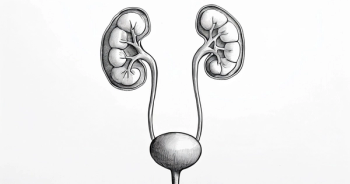
Peers & Perspectives in Oncology
- June I 2025
- Volume 3
Reviewing RCC Treatment Choices After Progression With IO/TKI
During a live event, Benjamin Garmezy, MD, discussed treatment options in renal cell carcinoma including IO/TKI combinations plus VEGF selectivity.
CASE SUMMARY
- The patient is a 61-year-old man, married, father of 2 grown children and 5 grandchildren who live nearby, active lifestyle (daily walks, golfs regularly)
- History of low-volume, indolent metastatic clear cell renal cell carcinoma (ccRCC), status post‒left nephrectomy and adrenalectomy
- Based on low-volume, indolent disease and patient preference: observation only
One and a half years post-nephrectomy CT scan:
- New paratracheal lymph node (2.0 x 1.5 cm) and more than 10 pulmonary nodules on CT
- Lung biopsy confirmed metastatic ccRCC
- Laboratory results: within normal limits
- ECOG performance status: 0
- The patient received first-line cabozantinib (Cabometyx) plus nivolumab (Opdivo).
Follow-up:
- Decrease or stabilization in metastatic lesions noted on follow-up imaging.
- He tolerated therapy well, with 1 interruption due to hypothyroidism on routine labs (treated with levothyroxine).
- Fourteen months after initiation of systemic therapy, the patient reported increasing back pain, mild nausea, weight loss, and new onset of persistent rib pain.
- Imaging confirms progressive disease: growth of paratracheal lymph node (was 20 x 15 mm; now 25 x 28 mm), new mediastinal and hilar nodal involvement, new retroperitoneal nodes and new lytic osseous lesions
- ECOG performance status: 1
Targeted Oncology: What are the other options in the frontline for patients with RCC?
Benjamin Garmezy, MD: In frontline therapy, you have basically 4 options. You have ipilimumab [Yervoy]/nivolumab, and you have the 3 immunotherapy/tyrosine kinase inhibitor [IO/TKI] regimens, cabozantinib/nivolumab, pembrolizumab [Keytruda]/lenvatinib [Lenvima], and pembrolizumab/axitinib [Inlyta]. Technically all 4 of them are category 1 for intermediate- and poor-risk disease. Three of them, the IO/TKI combinations, are also for favorable risk, though ipilimumab/nivolumab can be used in that space as well because there's now a good data set for that as well.1
Which subsequent-line options are available for this patient?
Moving on to subsequent-line therapy, prior IO therapy, there's no preferred regimen, because we don't have super high-quality data answering the question of what's the best going head-to-head against each other. We have a few options that you can use that are recommended regimens. None of these recommended regimens include immunotherapy. Ipilimumab/nivolumab is under useful in certain situations, pembrolizumab/lenvatinib and those other IO/TKI combinations are also under useful in certain situations.
Recommended regimens with the highest quality data are axitinib, belzutifan [Welireg], tivozanib [Fotivda], and everolimus plus lenvatinib. There are some footnotes there, in the sense that belzutifan is approved following a PD-L1 inhibitor and a VEGF TKI. If you use ipilimumab/nivolumab, belzutifan would not be a recommended regimen next. With tivozanib, [the question is]: Can you get away with it after an IO/TKI, or should you be progressing on 2 different lines of therapy? We can debate the language of the FDA approval, but technically you can use it. However, most of those patients in that study were on third line or later.
What is the importance of selectivity for the VEGF receptor in RCC?
Most of these drugs we talk about are multi-TKI receptors. They're targeting other [receptors]. These drugs have gotten more selective over time. Axitinib and tivozanib are more VEGF selective. [If you want] a pill that is going to maximally punch that VEGF receptor, that's axitinib and tivozanib. Pazopanib [Votrient], cabozantinib, and lenvatinib are more multi-kinase targeted.2
Is it a good option to rechallenge a patient with a VEGF TKI therapy?
When your patient cannot tolerate VEGF TKI therapy, sometimes—not always, because there's more similarities than differences—but sometimes you can get away with going to a different selective vs non-selective VEGF inhibitor and get success. So don't give up on VEGF TKI completely. Always consider how these drugs work. Where's that toxicity coming from? When you think about the toxicities, again, [there are] more similarities than differences, but there is a little bit of nuance as far as how [severe] is that hypertension toxicity profile vs the diarrhea or palmar-plantar erythrodysesthesia skin issue. You're going to get all of them with all of the regimens, but there's a little bit of differences based on this saturation of the VEGF receptor to the other targets that these pills inhibit.
When we think about the potency, cabozantinib, lenvatinib, axitinib, and tivozanib are more potent than the other drugs, and that's why we use them more frequently. We don't talk about pazopanib as much as we probably used to.
References:
1. NCCN. Clinical Practice Guidelines in Oncology. Kidney cancer, version 3.2025. Accessed March 27, 2025.
2. Fogli S, Porta C, Del Re M, et al. Optimizing treatment of renal cell carcinoma with VEGFR-TKIs: a comparison of clinical pharmacology and drug-drug interactions of anti-angiogenic drugs. Cancer Treat Rev. 2020;84:101966. doi:10.1016/j.ctrv.2020.101966







































